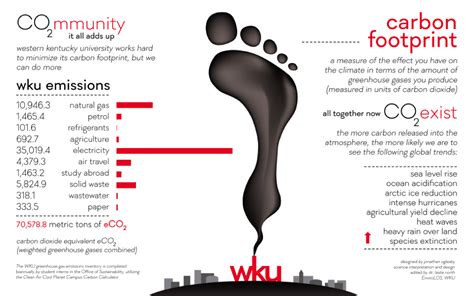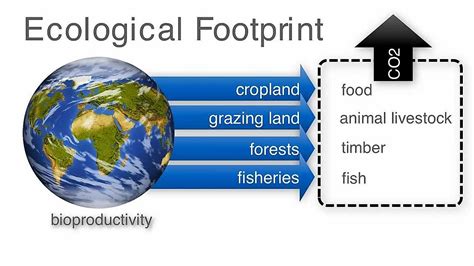Carbon Footprint Definition

In an era of increasing environmental awareness and climate concerns, the term "carbon footprint" has become increasingly prevalent. But what exactly does it mean? This article aims to provide an in-depth understanding of the concept, its significance, and its role in our efforts to mitigate the impacts of climate change.
Unraveling the Carbon Footprint

The carbon footprint refers to the total amount of greenhouse gas (GHG) emissions that are directly or indirectly caused by an individual, event, organization, or product. These emissions are typically measured in units of carbon dioxide equivalent (CO2e) and contribute to the greenhouse effect, which traps heat in the Earth’s atmosphere and leads to global warming.
Every human activity, from industrial processes to daily routines, leaves a carbon footprint. It encompasses a wide range of emissions, including carbon dioxide (CO2), methane (CH4), nitrous oxide (N2O), and fluorinated gases. While carbon dioxide is the most prevalent and widely recognized greenhouse gas, other gases also play significant roles in the overall climate impact.
Measuring Carbon Footprints
Calculating carbon footprints involves a comprehensive assessment of various activities and processes. For individuals, it includes emissions from transportation, energy use in homes and offices, consumption of goods and services, and even the food we eat. Organizations, on the other hand, have more complex footprints, encompassing emissions from their operations, supply chains, and the use of their products.
Here's a simplified breakdown of the main contributors to an individual's carbon footprint:
| Category | Typical Emissions |
|---|---|
| Transportation | Carbon dioxide from cars, planes, and public transport |
| Energy | Carbon dioxide and other gases from electricity generation and home heating/cooling |
| Consumption | Emissions from the production, transportation, and disposal of goods and services |
| Food | Methane and nitrous oxide from agriculture, land use, and food waste |

It's important to note that carbon footprints can vary significantly depending on factors such as location, lifestyle, and industry. For instance, emissions from air travel are much higher for frequent flyers, while certain industries, like cement production or agriculture, have inherently larger carbon footprints.
The Importance of Understanding Carbon Footprints

Grasping the concept of carbon footprints is crucial for several reasons:
- Climate Change Mitigation: By understanding our carbon footprints, we can identify areas where emissions can be reduced. This knowledge allows individuals, businesses, and governments to develop strategies to lower their environmental impact and contribute to global climate goals.
- Sustainable Decision-Making: Carbon footprint awareness enables us to make more informed choices. From selecting energy-efficient appliances to choosing low-carbon transportation options, our decisions can collectively make a significant difference in reducing global emissions.
- Corporate Responsibility: For businesses, calculating carbon footprints is a step towards environmental accountability. It helps identify areas for improvement in operations, supply chains, and product design, leading to more sustainable practices and potentially new market opportunities.
- Consumer Awareness: Understanding carbon footprints empowers consumers to make environmentally conscious choices. Whether it's opting for locally produced goods to reduce transportation emissions or choosing energy-efficient appliances, consumers can actively contribute to emissions reduction.
Reducing Carbon Footprints: Strategies and Solutions
Reducing carbon footprints is a collective effort that involves actions at various levels. Here are some key strategies and solutions:
- Energy Efficiency: Improving energy efficiency in homes, offices, and industries can significantly reduce carbon footprints. This includes using energy-efficient appliances, insulating buildings, and adopting renewable energy sources.
- Sustainable Transportation: Choosing low-carbon transportation options, such as walking, cycling, or using public transport, can drastically lower individual carbon footprints. For longer distances, electric vehicles and high-speed rail are more environmentally friendly alternatives.
- Sustainable Consumption: Opting for locally produced goods, reducing food waste, and choosing products with minimal packaging can all contribute to lower carbon footprints. Additionally, supporting sustainable and circular business models can drive systemic change.
- Offsetting Emissions: For certain activities that are difficult to avoid, such as long-distance travel, individuals and businesses can offset their emissions by investing in projects that reduce or remove greenhouse gases from the atmosphere, such as reforestation or renewable energy initiatives.
- Policy and Advocacy: Advocating for policies that promote sustainable practices and reduce emissions at a systemic level is crucial. This includes supporting renewable energy initiatives, advocating for better public transport infrastructure, and pushing for more stringent environmental regulations.
While individual actions are important, systemic changes are often necessary to make a substantial impact on carbon footprints. This is where collaboration between individuals, businesses, and governments becomes crucial. By working together, we can accelerate the transition to a low-carbon economy and mitigate the impacts of climate change.
Conclusion
The concept of carbon footprints is a powerful tool for understanding and addressing our environmental impact. By recognizing the various contributors to our carbon footprints and implementing strategies to reduce them, we can collectively make a difference in the fight against climate change. It is a journey that requires continuous learning, adaptation, and collaboration, but one that is essential for a sustainable future.
What is the average carbon footprint per person globally?
+The average global carbon footprint per person varies widely, influenced by factors such as economic development, energy sources, and lifestyle choices. As of [most recent data], the average global carbon footprint is approximately [value] metric tons of CO2e per person per year. However, this figure can range significantly, with higher-income countries typically having larger carbon footprints due to greater energy consumption and industrial activities.
How can I calculate my personal carbon footprint?
+Calculating your personal carbon footprint involves assessing your emissions from various activities, such as transportation, energy use, and consumption. There are numerous online calculators and tools available that can help you estimate your footprint. These tools often consider factors like your location, energy sources, and personal choices to provide a more accurate estimate.
Are there any industries or sectors with particularly large carbon footprints?
+Yes, certain industries have inherently larger carbon footprints due to the nature of their operations. Some of the most carbon-intensive sectors include fossil fuel extraction and refining, cement production, steel manufacturing, and agriculture, particularly livestock farming. These sectors often require significant energy inputs and produce large amounts of greenhouse gas emissions.



